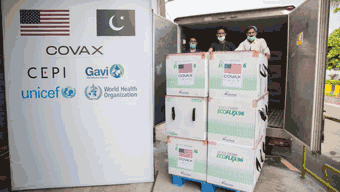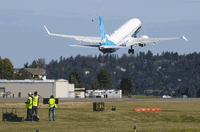
 |
| |
 |
 #INTHEAIREVERYWHERE |
| Vol. 20 No. 26 | Wednesday
July 7,
2021 |
| |
| Agreement between
the United States of America, the United Mexican States, and Canada (USMCA)
Implementing Regulations Related to the Marking Rules, Tariff-rate Quotas,
and Other USMCA Provisions is in the spotlight as Customs and Border Protection
(CBP) on July 1 issued two of its three highly anticipated U.S.-Mexico-Canada
Agreement (USMCA) regulatory packages setting forth requirements on a range
of issues. Trade attorneys advise customs brokers and freight forwarders should review, comment, and track the final outcome of these regulations and their application to North American cross-border trade to ensure compliance within their daily operations. CBP’s interim final rule includes implementing regulations for the preferential tariff treatment and related customs provisions of the USMCA. These rules, subject to comment within 60 days from publication, apply to goods from Canada and Mexico entered for consumption, or withdrawn from warehouse for consumption, on or after July 1, 2020. For more click here. |
We now know that new rules from ICAO have
forced change to air cargo as 100% industry screening went into effect
June 30.
|
 |
 Aviation
In the swamp until 2025—“The situation remains very challenging
for European aviation. We’re
heading into summer 2021 and most restrictions are still in place despite
encouraging progress on the vaccination front. So while we Aviation
In the swamp until 2025—“The situation remains very challenging
for European aviation. We’re
heading into summer 2021 and most restrictions are still in place despite
encouraging progress on the vaccination front. So while we  are
anticipating an uptick in summer traffic, our most likely medium term scenario
envisages a coordinated lifting of restrictions by Q1 2022 between regions,
which facilitates more long-haul travel. We’ll probably have around
50% of 2019 traffic for all of 2021 (5.5 million flights). By the end of
next year, traffic will only have recovered to 72% of 2019 levels, and will
only get back to close to where we were pre-pandemic by 2025,” says
Eamonn Brennan, (left)
Director General, Eurocontrol
. . . Winken-Blinken: The
recent delivery of 2.5M doses of the Moderna
vaccine from the United States
to Islamabad, Pakistan highlights
friendship and cooperation on COVID-19. “We are committed,”
said U.S. Secretary of State Blinken,
“to bringing this pandemic to an end around the world.” .
. . On July 1 A350 are
anticipating an uptick in summer traffic, our most likely medium term scenario
envisages a coordinated lifting of restrictions by Q1 2022 between regions,
which facilitates more long-haul travel. We’ll probably have around
50% of 2019 traffic for all of 2021 (5.5 million flights). By the end of
next year, traffic will only have recovered to 72% of 2019 levels, and will
only get back to close to where we were pre-pandemic by 2025,” says
Eamonn Brennan, (left)
Director General, Eurocontrol
. . . Winken-Blinken: The
recent delivery of 2.5M doses of the Moderna
vaccine from the United States
to Islamabad, Pakistan highlights
friendship and cooperation on COVID-19. “We are committed,”
said U.S. Secretary of State Blinken,
“to bringing this pandemic to an end around the world.” .
. . On July 1 A350  (registration
D-AIXP) “Lufthansa & You"
livery flew FRA to LAX
last weekend . . . United
Airlines' June 29 order of 70 Airbus
A321neo-aircraft & 200 B737Max
signals a narrow body future for business class among other things. United
stepping out quickly during the U.S. post pandemic recovery with the biggest
orders (USD$30 billion) in airline history for new airplanes from both Boeing
and Airbus, and an earlier
massive order in the yet to fly smaller electric airplane gains the carrier
an advantage over competitors, as COVID-19 fades in North America faster
than anywhere else . . . (registration
D-AIXP) “Lufthansa & You"
livery flew FRA to LAX
last weekend . . . United
Airlines' June 29 order of 70 Airbus
A321neo-aircraft & 200 B737Max
signals a narrow body future for business class among other things. United
stepping out quickly during the U.S. post pandemic recovery with the biggest
orders (USD$30 billion) in airline history for new airplanes from both Boeing
and Airbus, and an earlier
massive order in the yet to fly smaller electric airplane gains the carrier
an advantage over competitors, as COVID-19 fades in North America faster
than anywhere else . . .  Hopscotching
Headlines—At the moment the pandemic is far from over. IATA
figures remain down, as the rest of the world struggles to regain passenger
traffic. As June ended the number was 53% off 2019 levels .
. . Association of Asia Pacific
Airlines said, May numbers of 1.3 million passengers flying
international routes was just 4.3% versus May 2019 .
. . Airlines for America numbers
on June 30, 2021 saw passenger volumes internationally limping along at
45% pre-crises on international routes . .
. It’s Summer, Jump in the Sandbox! Etihad
Airways, Qatar Airways,
ELAL, Singapore
Airlines, Air Arabia,
Emirates and Oman
Air and some others have all opened up flights as Thailand’s
quarantine-free tourism pilot program for the resort island of Phuket
is now in full swing. The island, which was hit hard by economic losses
during the pandemic, started welcoming fully-vaccinated tourists on July
1, 2021. The “Phuket
Sandbox” program, that industry watchers are focused on right
now, is hoping to jumpstart Thailand’s ailing tourism industry that
has been reeling from pandemic losses (like everywhere else for more than
a year . . . Saudi
Arabia, in a bid to put itself on the enhanced airline map
of the world, reportedly is going to launch a new national Hopscotching
Headlines—At the moment the pandemic is far from over. IATA
figures remain down, as the rest of the world struggles to regain passenger
traffic. As June ended the number was 53% off 2019 levels .
. . Association of Asia Pacific
Airlines said, May numbers of 1.3 million passengers flying
international routes was just 4.3% versus May 2019 .
. . Airlines for America numbers
on June 30, 2021 saw passenger volumes internationally limping along at
45% pre-crises on international routes . .
. It’s Summer, Jump in the Sandbox! Etihad
Airways, Qatar Airways,
ELAL, Singapore
Airlines, Air Arabia,
Emirates and Oman
Air and some others have all opened up flights as Thailand’s
quarantine-free tourism pilot program for the resort island of Phuket
is now in full swing. The island, which was hit hard by economic losses
during the pandemic, started welcoming fully-vaccinated tourists on July
1, 2021. The “Phuket
Sandbox” program, that industry watchers are focused on right
now, is hoping to jumpstart Thailand’s ailing tourism industry that
has been reeling from pandemic losses (like everywhere else for more than
a year . . . Saudi
Arabia, in a bid to put itself on the enhanced airline map
of the world, reportedly is going to launch a new national  airline.
Crown Prince Mohammed bin Salman
said he wants a transportation and logistics effort that would land the
Kingdom as the fifth-biggest air transit hub in the world. The Saudi expansion
comes on the heels of Riyadh
announcing it would cease awarding contracts to firms that do not set up
regional headquarters in the Kingdom. The new airline is in line with an
effort to create new industries including tourism, and to more than double
travel volume via the Kingdom to 100 million
by 2030, from its present
day-40 million in 2019.
The move comes at a time of massive losses in UAE
with Emirates reporting an
incredible USD$5.5 billion
annual loss for its fiscal year recently that required a massive government
bailout. Neighbor Etihad Airways,
that today is a financial basket case, has unsuccessfully spent billions
investing in airlines that failed, whilst falling way short of the mark
in its attempt to build Abu Dhabi into a major hub .
. . airline.
Crown Prince Mohammed bin Salman
said he wants a transportation and logistics effort that would land the
Kingdom as the fifth-biggest air transit hub in the world. The Saudi expansion
comes on the heels of Riyadh
announcing it would cease awarding contracts to firms that do not set up
regional headquarters in the Kingdom. The new airline is in line with an
effort to create new industries including tourism, and to more than double
travel volume via the Kingdom to 100 million
by 2030, from its present
day-40 million in 2019.
The move comes at a time of massive losses in UAE
with Emirates reporting an
incredible USD$5.5 billion
annual loss for its fiscal year recently that required a massive government
bailout. Neighbor Etihad Airways,
that today is a financial basket case, has unsuccessfully spent billions
investing in airlines that failed, whilst falling way short of the mark
in its attempt to build Abu Dhabi into a major hub .
. . |
|
|
|
 |
For some time now the ominous truth has been that some of what we thought was good for us can also be bad for someone else. Take the pleasure of looking up into the sky at long thin and often romantic, really quite beautiful contrails from big passenger and cargo aircraft flying across the familiar to places yet to be discovered. Closer to the ground Sky Writers in summer with messages above beaches and homes are one thing. Up where the big jets play, it turns out those contrails of water vapor departing aircraft engines combining with water frozen in the air also generate residue that can form clouds and trap warmer air below causing cross-currents in our increasing environmentally aware world. In Europe tests are now underway by The German Aerospace Center (DLR) and The Maastricht Upper Area Control Centre (MUAC) to reduce aviation’s non-CO? climate and in this case that includes contrails. One method to diminish or possibly even erase contrails researchers say may be flight level changes, for example diverting aircraft 2,000 feet up or down from their normal flight path. But what about the good? Contrails like clouds in the sky are often strikingly beautiful and have inspired poets like Sandra Silkanowitz mother of a pilot who muses: Clear, knifelike, the jet cuts the sky, tracking blue with vivid white, colored by the sun’s prisms in pale streams of gold. Feather wisps of cloud trail the wake and dissolve into blue. The jet is gone. It leaves no mark, save the imprint of memory. Geoffrey |
If
You Missed Any Of The Previous 3 Issues Of FlyingTypers Access complete issue by clicking on issue icon or Access specific articles by clicking on article title |
||
 Vol. 20 No. 23 125 Million Reasons PayCargo Rules Chuckles for June 15, 2021 Air Canada Freighters Come October Hit Or Miss Trade Shows Pumping Traffic No American Way |
|
|
Publisher-Geoffrey Arend
• Managing Editor-Flossie Arend • Editor Emeritus-Richard
Malkin Film Editor-Ralph Arend • Special Assignments-Sabiha Arend, Emily Arend |
Send comments and news to geoffrey@aircargonews.com
|